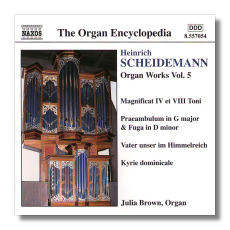
The Internet's Premier Classical Music Source
Related Links
- Latest Reviews
- More Reviews
-
By Composer
-
Collections
DVD & Blu-ray
Books
Concert Reviews
Articles/Interviews
Software
Audio
Search Amazon
Recommended Links
Site News
 CD Review
CD Review
Heinrich Scheidemann

Works for Organ, Volume 5
- Praeambulum for Organ in G Major
- Vater unser im Himmelreich II
- Magnificat im 8 Ton
- Angelus ad pastores ait
- Magnificat im 4 Ton
- Omnia quae fecisti nobis Domine
- Confitemini Domino
Julia Brown, organ
Naxos 8.557054
This is the last disk in a series surveying the organ works of Heinrich Scheidemann (c 1595-1663). Lovers of the North German early Baroque organ are advised to buy this recording now (and the other remaining Volumes, 3 and 4) while it's still available: Volumes 1 and 2 are no longer in the catalog.
A pupil of Sweelinck from 1611 to 1614, Heinrich Scheidemann to some extent benefitted from the richness which his home town, the Hanseatic Hamburg, had accrued since the early middle ages, and from his father's own skills as organist and the fact that he supported his son in his studies. It's tempting to perceive a kind of happy stability and celebratory joy coming from these solid beginnings in the music of Scheidemann. Whatever the causes, the music on this – and the others in this gem of a Naxos series – CD is splendid and splendidly positive music. Positive, though, doesn't mean lightheaded major key rallying: many of the movements here are somewhat sombre, thoughtful and even profound; the Magnificats, for example, are serious, weighty compositions which make quite an impact both at first hearing and once you're familiar with their intricacies and the way the music is developed. The wonderful little Kyrie is another example: short, melodically active and yet contemplative at the same time, it typifies the quiet confidence if its composer. Listen, too, to the Angelus ad pastores for the same unselfconscious qualities.
Volume 5 has two substantial Magnificats, IV and VIII Toni (second version). It's been conjectured that these were typically performed at Saturday afternoon vespers in the St. Catherine's church where Scheidemann spent most of his adult life as performer, composer and organ 'consultant', although the music was only discovered in the middle of the last century. Like the other largely liturgical pieces here, these works – designed to be played between the sung versus of the canticles – are placid while conveying Scheidemann's inner conviction. They're impressive pieces and impressively played (as is everything in this set) by accomplished organist and historical performance specialist Julia Brown on a modern organ in Eugene Oregon.
Of interest too are examples here of a dozen embellished versions by Scheidemann of motets by other composers… Hieronymus Praetorius, Hassler and Lassus. They are, of course, improvisatory in character yet never gratuitously spectacular. Executed by Brown with aplomb and restraint they nevertheless sparkle. There are also examples of the Praeambulum (Prelude) and a short Fugue in D minor.
This is music to savor, to return to and on each occasion to find new delights. If you're new to the repertoire, you won't find a better place to begin a rewarding journey of exploration. There is variety, insistence without indulgence and candidly good tuneful inventiveness. Brown's playing is exemplary and inspiring and the whole experience sumptuous without cloying. Recommended.
Copyright © 2007, Mark Sealey




















